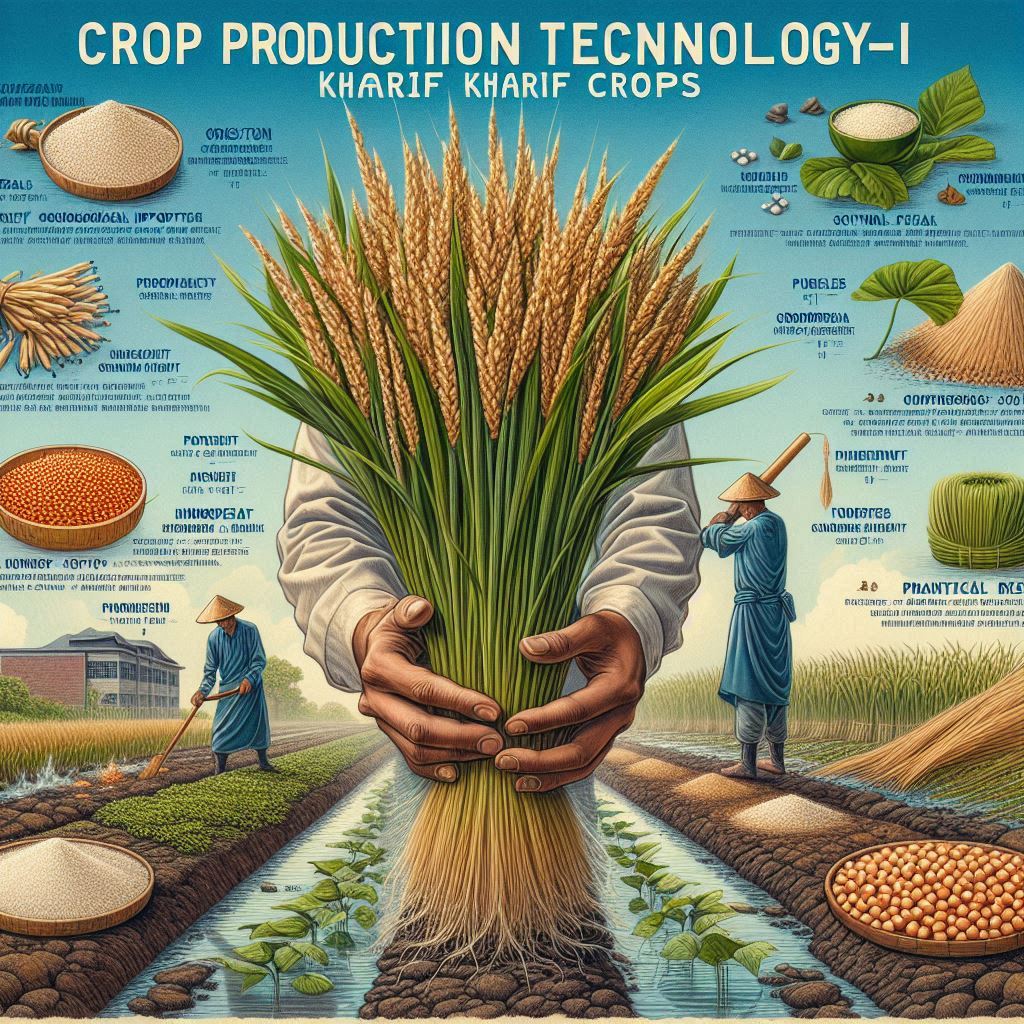AGRON – 211 Crop Production Technology – I (Kharif Crops)
RICE CULTIVATION NOTES BSc Agriculture
- RICE – Oryza sativa
- Family – Poaceae
- 2n- 24
- Origin place – India and Burma
Historical Background
- Ancient Cultivation: Rice has been a staple and the first cultivated crop in Asia, particularly in India.
- Evidence: Archaeological finds, like carbonised paddy at Hasthinapur (1000-750 B.C.), support its ancient origins.
- Cultural References: Rice is frequently mentioned in ancient Hindu scriptures and literature.
Origin Theories
- De Candolle (1886) & Watt (1892): Suggested South India as the origin of cultivated rice.
- Vavilov (1926): Proposed India and Burma as centers of rice cultivation.
Classification of Genus Oryza
- Species: 24 (22 wild, 2 cultivated – O. sativa and O. glaberrima)
- Distribution:
- O. sativa: Asia, America, Europe
- O. glaberrima: West Africa
Sub-species of Cultivated Oryza
- Indica
- Region: Tropics
- Characteristics:
- Long duration
- Photosensitive
- Mostly awnless
- Tall, weak-stemmed
- Susceptible to lodging
- Less responsive to heavy fertilizers
2.Japonica
- Region: Subtropical and temperate
- Characteristics:
- Dwarf stature
- Sturdy, non-lodging stems
- Short, thick, narrow, dark green leaves
- Awnless to awned
- Nearly round grains
- Fertilizer responsive
3.Javanica
- Region: Equatorial belt of Indonesia
- Characteristics:
- Intermediate between Indicas and Japonicas
- Long panicle with awned grains
- Low tillering
- Photoperiod sensitive
Geographical Distribution
- Global Importance: Rice is the world’s leading food crop, covering about 155 million hectares and producing 596 million tonnes of paddy.
- Caloric Contribution: Provides 22% of global calorie supply and 17% of proteins.
- Leading Producers: Major rice-producing countries include:
- India: 44.8 million hectares; 131 million tonnes produced (2nd in production).
- China: 200 million tonnes (1st in production).
- Other countries: Indonesia, Bangladesh, Vietnam, Thailand, Myanmar, Philippines.
Rice Cultivation in India
- State Leaders: Major rice-producing states include Andhra Pradesh, Bihar, Uttar Pradesh, Madhya Pradesh, and West Bengal.
- Production Leaders: West Bengal and Uttar Pradesh have the highest rice production.
- Yield: Punjab has the highest average yield (3346 kg/ha); national average is 2929 kg/ha.
Economic Importance
- Land Use: Rice farming is the largest use of land for food, covering 11% of arable land.
- Production Statistics: Approximately 600 million tonnes produced, with 90% in Asia.
- Economic Activity: Rice farming is vital for rural economies; it supports the majority of the world’s poor.
- Cultural Significance: Integral to social order and customs; used for debts, wages, and rent.
- Staple Food: Rice is synonymous with food in Asia and is the primary energy source for the poor.
- Longevity: Rice cultivation has a history spanning 10,000 years.
Climatic Conditions
- Altitude & Latitude: Grown from 8° to 35° N latitude and from sea level to 3000 meters.
- Ideal Climate: Requires hot and humid conditions with high humidity, prolonged sunshine, and ample water supply.
- Temperature Range:
- General Growth: 21°C to 37°C.
- Tilling Phase: Requires higher temperatures.
- Blooming: Optimal at 26.5°C to 29.5°C.
- Ripening: Ideal temperatures between 20°C to 25°C.
- Photoperiodicity: Primarily a short-day plant, though some varieties are non-sensitive to photoperiods.
Soil Requirements
- Soil Diversity: Can be grown in a wide range of soils, including alkaline and acidic types.
- Ideal Soil Characteristics:
- Water Retention: Soils with good water retention capacity.
- Texture: Clay or clay loams are preferred for their ability to hold water.
- Submerged Conditions: Thrives best in semi-aquatic environments; major cultivation occurs under lowland conditions.
- Soil pH Preference: Prefers acidic soils with a pH of 5.5 to 6.5, but can tolerate a variety of soil reactions.
- Alkali Soil Treatment: Can grow in alkali soils if treated with gypsum or pyrite.
Sowing Time- Rice is a Kharif crop, sown in monsoon season.
Important Varieties of Rice
- 1st high yielding dwarf variety is IR 8 (Dee gee woo gene × peta), known as miracle rice at international level released by IRRI in 1966.
- 1st dwarf variety of rice developed in the world is TN1 (Taichung Native 1) in Taiwan in 1965.
- 1st Indian high yielding variety (HYV) of rice is Jaya (TN1 × TN141), known as miracle rice of India released in 1968.
- Mutant variety – Jagannath (from TN141).
- Drought tolerant – Bala, Kanchan, Kiran, Bhawani, Sahbhagi Dhan, etc.
- BLB resistant – TKM 6 (also tolerant to stem borer), Ajay, etc.
- BLW tolerant – Govind, IR 20, etc.
- For water logging areas – Madhukar, Chakkaiya 59, Jalmagan (3-4 m standing water), etc.
- Salinity tolerant – IR 8, Damodar, Lunishree, CSR 5, CSR 10, CSR 23, SR 26 B, etc.
- 1st hybrid in India is MGR 1 (earlier it was known as CoRH 1) developed by TNAU.
- India is the 2nd country in the world to develop hybrids of rice after China.
- 1st HYV of basmati rice developed in India was Pusa Basmati 1.
- 1st super fine grain aromatic hybrid of basmati was developed in the world is PRH 10 (Pusa Rice Hybrid 10) by IARI.
- Other rice hybrids – APRH 1, APRH 2, KRH 1, KRH 2, etc.
- Submerge varieties – Swarna Sub 1 (14 days submerge)
- Post flooded variety – Kalinga 3
- For deep water – Pankaj, Jagannath, etc.
- Hilly regions variety – VL Dhan 206
- Rainfed – Narendra dhan 18.
Types of Rice Cultivation
I. Transplanted Puddled Lowland Rice
A. Nursery Management
i. Wet Nursery
- Nursery Area: Select 20 cents (800 m²) near a water source for raising seedlings for one hectare.
- Seed Rate:
- Long duration: 30 kg
- Medium duration: 40 kg
- Short duration: 60 kg
- Hybrids: 20 kg
Seed Treatment
- Fungicide Treatment:
- Use Carbendazim, Pyroquilon, or Tricyclozole at 2 g/l of water for 1 kg of seeds.
- Protects seedlings from blast disease for up to 40 days.
- Sprouting:
- Soak seeds, keep in a dark gunny bag for 24 hours to sprout.
- Bio-treatments:
- Pseudomonas fluorescens: Use talc-based formulation at 10 g/kg, soak overnight, sprout for 24 hours.
- Azospirillum: Use 3 packets (600 g/ha) and 3 packets of Phosphobacteria or 6 packets of Azophos (1200 g/ha), soak seeds overnight before sowing.
- Compatibility:
- Bio-control agents are compatible with bio-fertilizers.
- Fungicides and bio-control agents are incompatible.
Forming Seedbeds
- Mark plots 1.5 to 2.0m wide with 30cm wide channels around seedbeds.
- Seed bed length: 8 to 10m depending on soil and slope.
- Collect puddled soil from channels, spread on seedbeds, or drag a heavy stone to lower channels and raise seedbeds.
- Level the surface for proper water drainage.
Sowing
- Sow sprouted seeds uniformly with sufficient water in the nursery.
Water Management in nursery
- Drain water 18 to 24 hours after sowing.
- Avoid water stagnation in any part of the seedbed.
- Allow enough water to saturate the soil from 3rd to 5th day. From 5th day onwards, increase the water level from 1.5cm depending on the height of the seedlings.
- Thereafter maintain 2.5cm depth of water.
Weed and Nutrient Management in Lowland Rice Nursery
Weed Management
- Herbicides: Apply pre-emergence herbicides (Pretilachlor + safener @ 0.3kg/ha) on the 3rd or 4th day after sowing.
- Water Management: Maintain a thin film of water to control germinating weeds and avoid drainage.
Nutrient Management
- Organic Manure: Apply 1 tonne of fully decomposed FYM or compost to the 20 cents nursery, spread uniformly on dry soil.
- Basal Fertilization:
- For less fertile soils and pulling seedlings at 20-25 days:
- Before the last puddling, apply 40 kg DAP.
- If DAP is not available, use 16 kg urea and 120 kg super phosphate.
- For pulling seedlings after 25 days:
- Apply DAP 10 days before pulling out.
- Clayey Soils:
- Apply 4 kg of gypsum and 1 kg of DAP per cent of area 10 days after sowing to prevent root snapping.
ii. DRY NURSERY PREPARATION
- Dry ploughed field with fine tilth is required.
- Nursery area of 20 cents with sand and loamy soil status is more suitable for this type of
nursery. - Plots of 1 to 1.5m width of beds and channels to be formed. Length is according to the slope
and soil. Raised beds are more ideal if the soil is clayey in nature. - Seed rate and seed treatment as that of wet nursery.
- Sowing is dry seeding. Seeds are covered with sand and finely powdered well decomposed
farm yard manure. - Irrigation to be done to wet the soil to saturation.
- Optimum age for transplanting – 4th leaf stage.
- This type of nursery is handy in times of delayed receipt of canal water.
B. MAIN FIELD MANAGEMENT
Land preparation
- Plough the land during summer to economize the water requirement for initial preparation of
land. - Flood the field 1 or 2 days before ploughing and allow water to soak in. Keep the surface of
the field covered with water. - Keep water to a depth of 2.5cm at the time of puddling.
Optimum age of seedlings
- Optimum age of the seedlings is 18-22 days for short, 25-30 days for medium and 35-40
days for long duration varieties. - Pulling out the seedlings: Pull out the seedlings at the appropriate time (4th leaf stage).
Water management
- Puddling and leveling minimizes the water requirement
- Maintain 2.5cm of water over the puddle and allow the green manure to decompose for a
minimum of 7 days in the case of less fibrous plants like sunnhemp and 15 days for more
fibrous green manure plants like Kolinchi (Tephrosia purpurea). - At the time of transplanting, a shallow depth of 2cm of water is adequate since high depth of
water will lead to deep planting resulting in reduction of tillering. - Maintain 2 cm of water up to seven days of transplanting.
- About 5cm submergence has to be continued throughout the crop period.
- Moisture stress due to inadequate water at rooting and tillering stage causes poor root
growth leading to reduction in tillering, poor stand and low yield. - Critical stages of water requirement in rice are, a) panicle initiation, b) booting, c) heading
and d) flowering. During these stages, the irrigation interval should not exceed the stipulated
time so as to cause the depletion of moisture below the saturation level. - During booting and maturity stages, continuous inundation of 5cm and above leads to
advancement in root decay and leaf senescence, delay in heading and reduction in the
number of filled grains/panicle and poor harvest index. - Provide adequate drainage facilities to drain excess water or strictly follow irrigation
schedule of one day after disappearance of ponded water. Last irrigation may be 15 days
ahead of harvest.
Nutrient management
Apply 12.5 t of FYM or compost; or green leaf manure @ 6.25 t/ha.
- Apply fertilizer nutrients based on soil test recommendations.
- If soil test recommendations are not available, follow the blanket recommendations:
Blanket Recommendations (kg/ha)
| Variety/Season | N | P₂O₅ | K₂O |
|---|---|---|---|
| Short Duration Varieties (Dry Season) | |||
| a) Cauvery Delta & Coimbatore Tract | 150 | 50 | 50 |
| b) Other Tracts | 120 | 40 | 40 |
| Medium and Long Duration Varieties (Wet Season) | 150 | 50 | 50 |
| Hybrid Rice | 175 | 60 | 60 |
| Low N Responsive Cultivars (e.g., Improved White Ponni) | 75 | 50 | 50 |
Apply N and K in four equal splits viz., basal, tillering, panicle initiation and heading stages.
Tillering and panicle initiation periods are crucial and should not be reduced with the
recommended quantity.
Phosphorus (P) Fertilizer
- Apply P as basal and incorporate it into the soil.
- For green manure application, use rock phosphate as a cheap P source. When using rock phosphate, no additional P is needed for the succeeding rice crop.
- Mixtures of rock phosphate + single super phosphate (SSP) or DAP in ratios of 75:25 or 50:50 are as effective as using SSP or DAP alone.
Zinc Sulphate
- Apply 25 kg of zinc sulphate mixed with 50 kg dry sand before transplanting.
- If using green manure (6.25 t/ha) or enriched FYM, apply 12.5 kg zinc sulphate/ha.
- For Zn deficiency, use foliar application of 0.5% zinc sulphate + 1.0% urea every 15 days until symptoms disappear.
Gypsum
- Apply 500 kg of gypsum/ha during the last ploughing as a source of calcium (Ca) and sulfur (S).
Foliar Nutrition
- Apply a foliar spray of 1% urea + 2% DAP + 1% KCl at panicle initiation (PI) stage and again 10 days later for all varieties.
Neem-Treated Urea
- Mix urea with crushed neem seed or neem cake (20% by weight). Powder neem cake to pass through a 2mm sieve before mixing. Keep overnight before use.
- Alternatively, mix urea with gypsum in a 1:3 ratio or with gypsum and neem cake in a 5:4:1 ratio to increase nitrogen use efficiency.
Weed Management
- Essential to remove weeds close to the rice root zone.
- Dual cropping of rice-Azolla can reduce weed infestation.
- Summer ploughing and cultivating irrigated dry crops during post-rainy periods also help reduce weeds.
Pre-Emergence Herbicides
- Use Butachlor 1.25 kg/ha or Anilophos 0.4 kg/ha as pre-emergence applications.
- Alternatively, use a mixture of Butachlor 0.6 kg + 2,4 DEE 0.75 kg/ha, or Anilophos + 2,4 DEE ‘ready-mix’ at 0.4 kg/ha followed by one hand weeding at 30-35 days after transplanting (DAT).
- Mix herbicides with 50 kg of dry sand on the day of application (3-4 DAT) and apply uniformly to fields with a thin film of water. Avoid draining or fresh irrigation for 2 days after application.
Post – emergence herbicides
- If pre-emergence herbicide application is not done, hand weeding has to be done on 15th
DAT. - 2,4-D sodium salt (Fernoxone 80% WP) 1.25 kg/ha dissolved in 625 litres with a high
volume sprayer, three weeks after transplanting or when the weeds are in 3-4 leaf stage.
Harvesting
- Water Management: Drain water from the field 7-10 days before the expected harvest date to hasten maturity and improve harvesting conditions.
Identifying Maturity
- Visual Check: When 80% of the panicles turn straw-colored, the crop is ready for harvest. Note that some varieties’ leaves may remain green.
- Physical Check: Select the most mature tiller, dehusk a few grains. If the rice is clear and firm, it is in the hard dough stage.
- Panicle Check: When most grains at the base of the panicle are in the hard dough stage, the crop is ready.
Harvesting Process
- Harvesting: Cut the crop when mature, thresh, and winnow the grains.
- Drying: Dry the grains to a 12% moisture level for storage.
- Moisture Level for Yield Estimation: Grain yield is estimated at 14% moisture for comparisons.
- Hasten Maturity: Spray 20% NaCl a week before harvest to hasten maturity by 3-4 days and avoid monsoon rains.
Yield
- Grain Yield: 4000 to 6000 kg/ha, depending on management and climatic conditions.
- Straw Yield: 8000 to 10000 kg/ha.
SYSTEM OF RICE INTENSIFICATION (SRI) CULTIVATION
- Dry season with assured irrigation is more suitable.
- Difficulty in crop establishment may be seen in areas with heavy downpour
Varieties: Hybrids and varieties with heavy tillering - Seed rate: 7- 8 kg for single seedling/hill.
- Prepare 100 m2 nursery to plant 1 ha area. Select a leveled area near the water source.
- Spread a plastic sheet or used polythene gunny bags on the shallow raised bed to prevent roots growing deep into soil.
- Seedlings reach sufficient height for planting at 15 days. Lift the seedling mats and transport them to main field.
- Single seedling of 15 days old.
- Square planting of 25 x 25 cm.
- Fill up the gaps between 7 and 10 DAT.
- Transplant within 30 minutes of pulling out of seedlings.




![[PDF] BSc Agriculture 3rd semester Notes Download](https://eagronomy.com/wp-content/uploads/2024/09/AddText_09-23-09.27.27.jpg)



Pingback: MAIZE (Zea mays) Cultivation Notes BSc Agriculture
Pingback: SORGHUM (Sorghum bicolor) Cultivation Notes BSc Agriculture
Pingback: Crop Production Technology – I (Kharif Crops) B.Sc. Ag 3rd Semester Notes